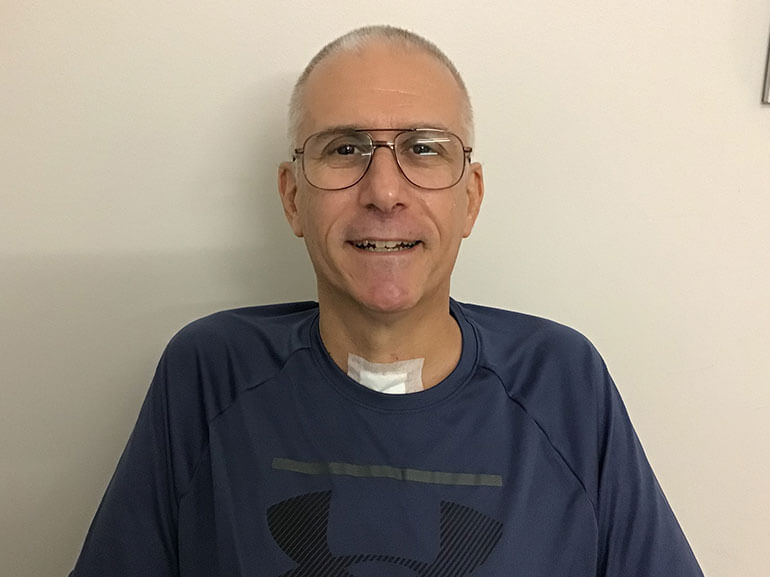Joseph's Story

Joseph LaFerriere, 56, lives in Slidell, Louisiana with his wife, Adele, and son. He has worked for UPS for 27 years driving trucks from New Orleans to other locations. Before getting sick with COVID-19, Joseph worked full-time and enjoyed working on models of cars and ships.
After experiencing worsening symptoms, Joseph was admitted to Slidell Memorial Hospital and diagnosed with the virus. Within two weeks, Joseph’s health significantly declined with his right lung collapsing requiring intubation and placement of a tracheostomy to assist with his breathing. During this time, he was mostly unaware of what was happening, and as a result, unable to participate in therapy due to his level of consciousness.
After stabilizing, Joseph transferred to Northshore Extended Care. When admitted to the long-term acute care facility, he could only wiggle his fingers and turn his head. He was unable to lift his arms or do anything for himself. He also still had his chest tubes, tracheostomy and a feeding tube and was on three liters of oxygen. Therapists worked with Joseph to lift his arms and sit in a cardiac chair with assistance. He was also finally able to have the chest tubes and tracheostomy removed.
In time, he was ready for the next step in recovery so Adele began searching for an inpatient rehabilitation option and found Northshore Rehabilitation Hospital. She heard it was a top-notch rehabilitation hospital and decided it would be the best place for Joseph. When admitted, Joseph still had weakness in his arms, a feeding tube and was unable to perform basic self-care tasks. He immediately set a goal for himself to walk by his birthday.
When Joseph started his physical and occupational therapy, he was unable to walk. His physical therapy team worked on standing and walking in the parallel bars with assistance, walking with a walker, climbing stairs, using resistance bands and using the leg stair stepper machine to build strength and endurance. During occupational therapy, Joseph worked on learning how to bathe and dress himself again. He also received arm strengthening therapy using weights, did wheelchair push-ups, and worked his upper extremity using an arm bike to increase functional strength and endurance.
Joseph says that when he was able to walk with a walker for 10 feet he felt euphoric and it was a turning point for him in his recovery. He said, “I felt like I could even possibly do more. I was thinking like ‘The Little Engine That Could,’ but actually I was the steamroller that’s just not going to stop!”
After two weeks of intense therapy, Joseph was able to walk 222 feet nearly on his own and was weaned down to 1.5 liters of oxygen. He still had the feeding tube at discharge, but was cleared to eat a normal, solid diet. Joseph was also able to perform basic self-care tasks such as getting dressed, showering and feeding himself independently.
Joseph says that his wife and son were a wonderful support system every step of the way. “They were fighting for me from the beginning.” He is looking forward to going home and being with his family and his two Jack Russell terriers. He is also looking forward to regaining his independence and eventually getting back to work.
When asked about his recovery journey, Joseph stated, “My experience was outstanding! The doctors, therapists and nursing staff believed that I could do anything I set my mind to, and they helped me maintain my positive attitude.”
Joseph also offered this advice to others facing recovery: “You have to temper what you want to do with what you can do. Just take it in stages and push yourself. This has been some of the hardest work I’ve ever done, but has also been the most rewarding.”